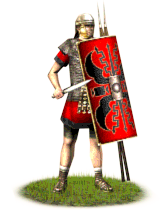Difference between revisions of "Early Legionary Cohort (RTW Unit)"
(Created page with "{{TW Unit|image= Image: ROMAN_LEGIONARY_COHORT_I_INFO.png |Class= Heavy Infantry |Unit Size= 161 men |Weaponry= <li>Pila</li><li>Sword</li> |Morale= 10 |Melee Attack= 9 ...") |
Tango12345 (talk | contribs) m (Removed category "Rome Total War Units"; Quick-adding category "RTW Units" (using HotCat)) |
||
| Line 39: | Line 39: | ||
<li>[[Image:Scipii_Faction_Symbol-Vanilla.png |36px]][[Scipii_(RTW_Faction) |The House of Scipii]]</li> | <li>[[Image:Scipii_Faction_Symbol-Vanilla.png |36px]][[Scipii_(RTW_Faction) |The House of Scipii]]</li> | ||
| − | [[Category: | + | [[Category: RTW_Infantry]] |
| + | [[Category:RTW Units]] | ||
Revision as of 08:38, 30 May 2017
![]() Well-armed and armoured infantrymen, who go into combat flinging heavy spears that are followed up with hand-to-hand attacks.
Well-armed and armoured infantrymen, who go into combat flinging heavy spears that are followed up with hand-to-hand attacks.
Overview
Roman legionaries are tough, professional troops with good armour and superb weapons. Their hallmarks are discipline, obedience and tactical flexibility. When approaching enemy fortifications, for example, they can use the turtle formation, or testudo, overlapping their shields for protection.
Every legionary’s chainmail armour, the lorica hamata, is of very good quality, as is the rest of his gear: a metal helmet and a large curved shield. They fight with two throwing spears (the pilum, plural pila) and a short stabbing sword, the gladius. Each pilum has a soft iron shaft behind the piercing head that is designed to bend as soon as it hits a target, making it impossible to pull out and throw back. Embedded in a shield a pilum hampers an enemy. Embedded in a man, it usually kills. Once the pila have been thrown, legionaries close and continue fighting with the stabbing gladius.
Historically, these legionaries only came to be after the army reforms of Gaius Marius. He abandoned property and age requirements for the legions, and made the Roman army into a professional force. No longer would a man have to provide his own war gear; he would be paid, serve a term of 25 years and then retire with enough land to give him a pension for the remainder of his days.
Details
These are the Romans’ initial, basic post-Marian legionaries. Early Legionary Cohorts, like the rest of Rome’s standard legionary infantry, are armed with two pila and a sword. They have decent armor, as well as a much higher attack and morale than preceding Auxilia. Although generally good on the battlefield, Early Legionary Cohorts are also the beginning of a more expensive streak of soldiers.
Early Legionary Cohorts are the most inexpensive Roman unit that can form a testudo (meaning “tortoise” in Latin). In this formation soldiers form a ‘shell’ of shields around them in a sturdy, but slow and inflexible, formation practically impervious to missiles.
